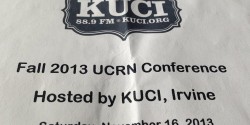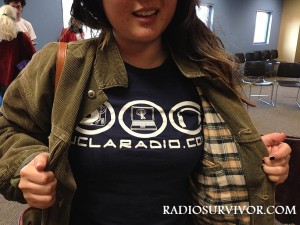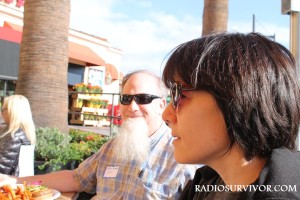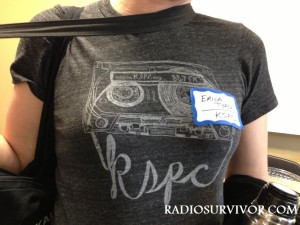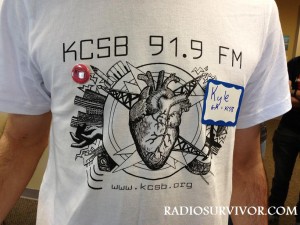On Saturday I was in Southern California for the University of California Radio Network (UCRN)’s fall conference.
Held at KUCI at University of California at Irvine, the event drew college radio participants from all over California, including representatives from KUCI, KXLU (Loyola Marymount), KSPC (Pomona College), KCSB (UC Santa Barbara), KZSC (UC Santa Cruz), and UCLARadio.
For me, UCRN is always a great chance to not only tour a college radio station (it was my second trip to KUCI and my 8th UCRN!), but to also connect with old friends and learn more about what other stations are up to. Following a meet-and-greet breakfast of waffles, fruit, and pastries, participants broke off into a series of panel discussions and workshops. Topics included: Motivating Volunteers, Live Sound 101, Making Your Station Matter (to your campus/license holder), Music Roundtable, and Recruiting Student DJs and Student Listeners.
I was amazed to learn about the high level of student interest in college radio at some stations. KCSB recently had 350 people in its training program, which began with hands-on experience at its campus-only sister station KJUC-AM for a quarter.
KZSC Broadcast Advisor Michael Bryant reported that this fall there were around 250 new student volunteers. Not all of those volunteers will be able to get on the air immediately, as it’s a competitive process to get into the required broadcasting class. Students must first do at least 20 hours of volunteer work at the station in order to qualify to take the class. Even after completing those hours, there are only 14 available spots in the class.
UCLARadio collected around 150-200 email addresses of students interested in volunteering at the station during an activity fair this year and ended up with around 100 applicants to its intern class.
From those applicants, around 40 interns were selected. At KUCI, around 35 people typically start out in the station’s training class.
A resounding theme was that although recruitment can be easy, retaining volunteers can be more challenging. Many stations require participants to volunteer for a specified number of hours in order to not only get a permanent air shift, but also to maintain that shift.
KCSB requires 8 hours of work per quarter, for example. One way that volunteers can accrue a bunch of hours at once is through occasional 4-hour Saturday work days (called “Shakedown” events). KSPC’s volunteer coordinator Edie Adams also recommended giving volunteers a choice of concrete tasks in order to make it more likely for people to do the work. She also suggested group activities, such as CD review parties.
In addition to creating a healthy and productive station community, it’s also important for college radio stations to maintain good relationships with their home campus.
Erica Tyron, Director of TV and Radio at Pomona College and KSPC’s Station Manager, led a session on the topic of “Making Your Station Matter.” Based loosely on a similar session at the recent CBI conference in San Antonio (more about that later this week), the discussion offered some ideas for fostering good will with campus administrators and staff.
Tyron shared that KSPC had done a brief presentation about the station at a campus staff meeting so that people in other departments were aware of what the station did.
This resulted in increased awareness about volunteering at the station (faculty and staff can apply for shows too) as well as helped to spread the word about the ability to submit public service announcements and event listings. Additionally, it led to an invitation to present at a board of trustees meeting.
Tyron said that it was important to bring students to that meeting and she explained that it was incredibly powerful for trustees to see first-hand how being at the station “transformed the lives of students.”
She also recommended that stations have an open dialogue with their campus presidents, particularly building an understanding of how one’s station contributes to the school’s educational mission. KZSC is lucky in that its volunteers regularly participate in a quarterly student media meeting with the chancellor of UC Santa Cruz.
Other stations mentioned some successful campus collaborations, including some forthcoming KXLU events at the campus library, which will feature live music. Additionally, KXLU plans to partner with the Loyola Marymount Political Science Department’s Center for the Study of Los Angeles in order to present news about Los Angeles over the airwaves. KSPC also provides live DJs for an “Art After Hours” event at a museum on campus.
Social media was also cited as another way for stations to directly connect with the broader campus. Tyron said that the communications office has been more active on Twitter and will often take notice of tweets about KSPC, particularly when there are interesting photos of the station or events. KZSC has had big success with its Instagram account and is followed by many faculty and staff on campus.
Perhaps most important of all, some stations are vital parts of their campus emergency plans (namely KZSC, which was near the epicenter of the Loma Prieta earthquake in 1989) so that they can provide news and information in times of crisis. Because of that, several stations have back-up generators in case of a power outage.
Before the conclusion of the day, participants migrated to the KUCI studios for a station tour. Although I’d been there once before (for the Spring 2012 UCRN conference), I relished the chance to take some more pictures.
A unique thing about KUCI is that it’s located away from central campus in a portable prefabricated bungalow building. Its cozy home contains studios, shelves full of vinyl records and CDs, broadcasting equipment, and even a bathroom. A big highlight is the jam-packed pop culture mecca in advisor Kevin Stockdale’s office.
Thanks to everyone at KUCI for your hospitality during the UCRN event. I hope to write up a fuller report about my station tour soon. Keep an eye on Spinning Indie to see that, as well as field trip posts from many other University of California radio stations. Also, be sure to check back this Friday for more college radio news in my new weekly College Radio Survivor feature.

